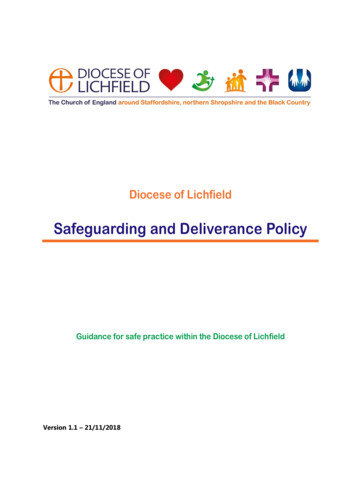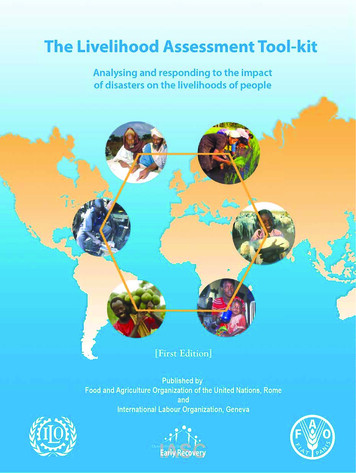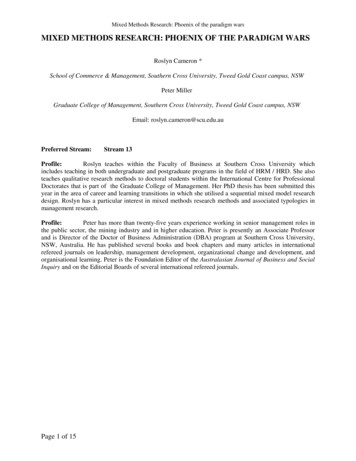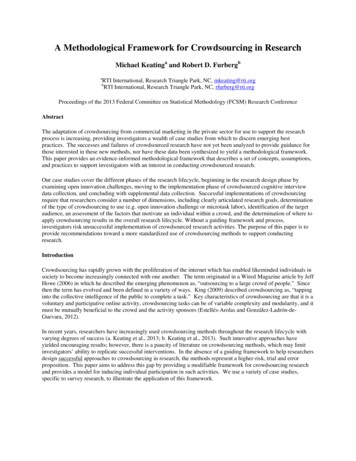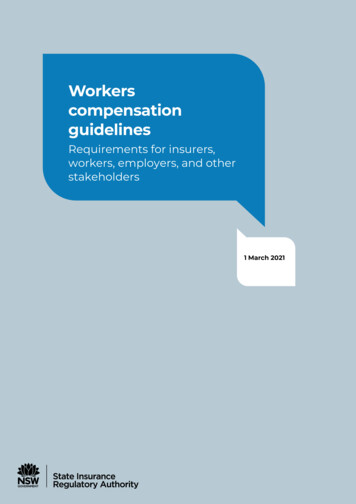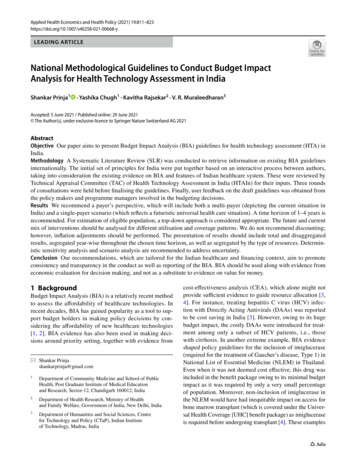
Transcription
Applied Health Economics and Health Policy (2021) 68-yLEADING ARTICLENational Methodological Guidelines to Conduct Budget ImpactAnalysis for Health Technology Assessment in IndiaShankar Prinja1· Yashika Chugh1 · Kavitha Rajsekar2 · V. R. Muraleedharan3Accepted: 5 June 2021 / Published online: 29 June 2021 The Author(s), under exclusive licence to Springer Nature Switzerland AG 2021AbstractObjective Our paper aims to present Budget Impact Analysis (BIA) guidelines for health technology assessment (HTA) inIndia.Methodology A Systematic Literature Review (SLR) was conducted to retrieve information on existing BIA guidelinesinternationally. The initial set of principles for India were put together based on an interactive process between authors,taking into consideration the existing evidence on BIA and features of Indian healthcare system. These were reviewed byTechnical Appraisal Committee (TAC) of Health Technology Assessment in India (HTAIn) for their inputs. Three roundsof consultations were held before finalising the guidelines. Finally, user feedback on the draft guidelines was obtained fromthe policy makers and programme managers involved in the budgeting decisions.Results We recommend a payer’s perspective, which will include both a multi-payer (depicting the current situation inIndia) and a single-payer scenario (which reflects a futuristic universal health care situation). A time horizon of 1–4 years isrecommended. For estimation of eligible population, a top-down approach is considered appropriate. The future and currentmix of interventions should be analysed for different utilisation and coverage patterns. We do not recommend discounting;however, inflation adjustments should be performed. The presentation of results should include total and disaggregatedresults, segregated year-wise throughout the chosen time horizon, as well as segregated by the type of resources. Deterministic sensitivity analysis and scenario analysis are recommended to address uncertainty.Conclusion Our recommendations, which are tailored for the Indian healthcare and financing context, aim to promoteconsistency and transparency in the conduct as well as reporting of the BIA. BIA should be used along with evidence fromeconomic evaluation for decision making, and not as a substitute to evidence on value for money.1 BackgroundBudget Impact Analysis (BIA) is a relatively recent methodto assess the affordability of healthcare technologies. Inrecent decades, BIA has gained popularity as a tool to support budget holders in making policy decisions by considering the affordability of new healthcare technologies[1, 2]. BIA evidence has also been used in making decisions around priority setting, together with evidence from* Shankar Prinjashankarprinja@gmail.com1Department of Community Medicine and School of PublicHealth, Post Graduate Institute of Medical Educationand Research, Sector‑12, Chandigarh 160012, India2Department of Health Research, Ministry of Healthand Family Welfare, Government of India, New Delhi, India3Department of Humanities and Social Sciences, Centrefor Technology and Policy (CTaP), Indian Instituteof Technology, Madras, Indiacost-effectiveness analysis (CEA), which alone might notprovide sufficient evidence to guide resource allocation [3,4]. For instance, treating hepatitis C virus (HCV) infection with Directly Acting Antivirals (DAAs) was reportedto be cost saving in India [3]. However, owing to its hugebudget impact, the costly DAAs were introduced for treatment among only a subset of HCV patients, i.e., thosewith cirrhosis. In another extreme example, BIA evidenceshaped policy guidelines for the inclusion of imiglucerase(required for the treatment of Gaucher’s disease, Type 1) inNational List of Essential Medicine (NLEM) in Thailand.Even when it was not deemed cost effective, this drug wasincluded in the benefit package owing to its minimal budgetimpact as it was required by only a very small percentageof population. Moreover, non-inclusion of imiglucerase inthe NLEM would have had inequitable impact on access forbone marrow transplant (which is covered under the Universal Health Coverage [UHC] benefit package) as imigluceraseis required before undergoing transplant [4]. These examplesVol.:(0123456789)
812Key Points for Decision MakersOur recommendations for the conduct of Budget ImpactAnalysis (BIA) aim to promote consistency and transparency in the conduct as well as reporting of the analysis.To our knowledge, this is the first set of BIA recommendations for India, which addresses the intricacies of thehealthcare system and financing in India.Our recommendations are a set of robust guidelines,which can be used to assess drugs, health technologiesas well as health programmes in contrast to the existingguidance being available to assess financial impact ofmainly drugs and devices.Both BIA and cost-effectiveness analysis (CEA) areindependent tools, which aid the process of evidenceinformed decision making and complement the findingsof each other. Thus, these are not to be considered asubstitute for each other.illustrate that both BIA evidence as well as cost effectivenessshould together guide decision makers.BIA can be a highly informative assessment as we movetowards achieving UHC, especially in resource constrainedsettings. As per the stated policy goals, India is committed towards achieving UHC [5]. However, the allocation tohealth is not commensurate with the aspirational goals [5,6]. With such restrained budget, affordability and financialsustainability assessments become equally important alongside value for money when making decisions on resourceallocation between competing healthcare technologies. Second, the National Health Policy 2017 envisions an increasein the government health expenditure to 2.4% of the GrossDomestic Product (GDP) by 2024 [6–8]. Third, the Indiangovernment’s flagship health scheme, Ayushman Bharat,was announced recently, which includes two components:creation of health and wellness centres (HWCs) for strengthening primary health care and the ‘Pradhan Mantri JanArogya Yojana’, which is an insurance programme to coverhospitalisation expenditures [9]. Together, this implies anincreased pressure on expanding the basket of services andinterventions to be provided, and increase their populationcoverage, which further places utmost importance on theneed to prioritise the available resources in a sustainableway [10].The Health Technology Assessment in India (HTAIn)—India’s official HTA agency [11, 12], has produced a processmanual, which also specifies a reference case to conductCEA [13]. However, there are no BIA guidelines specific tothe Indian context. The International Society for Pharmacoeconomics and Outcomes Research (ISPOR) has publishedS. Prinja et al.the principles of good practice to follow when developingand reporting a BIA [14, 15]. In addition, a number of countries have developed their own country-specific guidelinesto address aspects that are specific to their healthcare system[16–19]. However, the generalisability of these guidelines tothe Indian context is limited owing to contextual differencesin the health financing system in India.The healthcare system in India differs in many aspectsfrom other countries where BIA guidelines are available[20–23]. The private sector in India predominates over public in provision of healthcare and a significant proportionof healthcare is financed through household out-of-pocketexpenditure (OOPE) [24, 25]. Furthermore, health financing structure includes a complex mix of demand as well assupply-side financing mechanisms [26, 27]. The supply-sidefinancing system refers to the funding flows that are createdto invest on development of health infrastructure, pay fora supply of human resources, drugs and consumables, etc.[28]. These are usually guided by norms of payment for eachlevel of health facility. There is no explicit linkage betweenthe level of funding received and volume of services delivered in a supply-side financing route. On the contrary, in ademand-side financing system, money follows the patient/consumer. The provider gets paid according to the volumeof services delivered or number of patients treated [28].The payment system under all publicly financed insurancesystems in India is an example of demand-side financing.Historically, the financing of public healthcare in India waslargely supply-side driven. However, with the recent risein number of publicly financed health insurance schemes,there is a transition to demand-side approach for financinghealthcare [29]. The launch of Ayushman Bharat—PradhanMantri Jan Arogya Yojana (AB PM-JAY) is a major stepforward in this direction [9]. The demand-side financingoperates through two types of mechanisms, i.e., a ‘publictrust model’ where the government purchases the servicefrom other public or private providers or an ‘insurancebased model’, wherein the government acts as the centralfunding agency but the purchasing of healthcare is by theinsurance intermediary [30]. Overall, demand-side financing aims at improving access to healthcare and encouragesupply of healthcare, for example, public health insuranceschemes [30]. These are important contextual differencesthat should be considered when computing a framework toassess financial consequences of the introduction of newhealthcare technologies or interventions.Consequently, in order to meet the current requirementof using BIA alongside CEA to incorporate evidence onfinancial sustainability and affordability in HTA decisionmaking, it is important to develop and use a set of methodological recommendations, which takes into consideration the specific features of Indian healthcare financing anddelivery system. These recommendations can be used by
National Budget Impact Analysis Guidelines for Indiahealthcare decision makers at both micro (for example, hospitals, district) and macro (regional, state and centre) level,as well as HTA researchers who wish to conduct BIA toinform decision making in health. Decision makers couldbe policy makers with responsibility of deploying funds.The interventions could range from services that are a partof the benefit package under the AB PM-JAY to supplyside funded interventions provided through State or CentralGovernment funding or National Health Mission (NHM).Any intervention aimed at improving the health of a givenpopulation including pharmaceuticals; medical devices;diagnostic/screening techniques; surgical procedures; othertherapeutic technologies; preventive or other public healthprogrammes can be assessed for budget impact.In this paper, we aim to present the BIA guidelines forits conduct specific to Indian context, allowing for the flexibility to estimate the financial impact for different budgetholders and at different organisational levels within theIndian healthcare system.2 Guidelines Development ProcessThe work for developing BIA guidelines was commissioned by HTAIn, Department of Health Research (DHR).The development of the present BIA guidelines involved amulti-step approach to ensure recommendations are basedon all available evidence on BIA and are appropriate considering the complexity of the Indian healthcare system. A Systematic Literature Review (SLR) was conducted to retrieveinformation on all currently available BIA guidelines internationally [31]. The initial set of BIA principles for Indiawere put together via an interactive process between authorsand taking into consideration both existing BIA evidence[31] and the features of the healthcare system in India. Theauthors deliberated on why the existing BIA guidelines cannot be adapted to the Indian scenario, and which featuresof existing guidelines can be generalised. The healthcareservice delivery and financing were discussed in detail toformulate BIA costing and modelling approach. In addition,the guiding principles were formulated to set an appropriate time horizon for BIA. Similarly, the recommendationon each guiding principle were discussed in light of opinionof each author and a consensus was generated amongst allby discussion.After preparation of the initial draft, the guidelines werecirculated three times via e-mails to the members of Technical Appraisal Committee (TAC) of HTAIn for their inputsand suggestions. After obtaining comments and feedback bye-mail, the revised guidelines were presented twice in virtual813meetings to discuss the recommendations. Eight members ofthe TAC, and 13 members of the HTAIn secretariat participated in these meetings. In addition, seven members fromthe regional resource centres (RRC) were also a part of thesevirtual meetings. RRCs are the academic and research organisations where HTA studies are commissioned by HTAIn toconduct evaluation. The members of RRCs who participatedin the meetings were researchers who are involved in conducting HTA assessments, including BIA. In view of thecurrent coronavirus disease (COVID)-19 pandemic, it wasnot possible to have face-to-face meetings, and hence, virtualmeetings were held.Based on the inputs and suggestions received via e-mailcommunication and during these two virtual meetings,two sets of revisions were made. After the guidelines wereapproved by the TAC, these were shared with a panel ofusers of BIA evidence who are involved in undertakingbudgetary decision-making for allocation of resources acrossdifferent programmes and policies in varying capacities.The users to be interviewed were purposively selected. Thispanel included nine bureaucrats, policy makers and technical experts responsible for budgetary decision-makingin the Indian health system. We first circulated the BIAdraft guidelines to these experts via e-mail. Two of thesedid not respond even after two reminder e-mails. Amongthose who responded and provided feedback, three users hadexperience of working at the national level, while four usersworked at the State level. In terms of financing models inwhich the users worked, five were involved in a supply-sidefinancing system and two users in the demand-side financingschemes. Similarly, while three users were involved in globalbudgeting decisions, the remaining four users were responsible for making decisions about single health programmesor schemes or interventions.The users or policy makers or budget holders on the panelresponded to the guideline document with their queries,seeking clarifications, providing their suggestions and overall feedback on the document. To resolve the queries and toassess the understanding of the experts regarding the document, one-to-one telephonic interviews were conducted foreach of these seven experts. None of the expert commentsled to any disagreement in broad principles as most of thecomments were generic, seeking further clarification on different aspects in the document. Majority of the suggestions,which were to provide greater details, were incorporated. Afew comments, which were beyond the scope of BIA, wereexplained to the experts to gain consensus. This completeprocess, that included e-mail communications, virtual meetings and expert interviews, was completed over a period offive months from June to October 2020.
8143 Recommendations For conduct of BIAin India3.1 Perspective“BIA from the budget holder’s or payer’s perspective should be done from two scenarios. First, using a‘multi-payer’ perspective to assess the current existing share of budget holder and out of pocket (OOP)expenditure, which is the existing situation in Indiawhere healthcare expenditure is borne by the government as well as the patients. Second, using a ‘singlepayer’ perspective where universal access to serviceswould be guaranteed by the budget holder without anyOOP expenditure.”BIA is a computational framework to be used alongsideCEA to provide information on the resources required tofund a new intervention. Together with information on thelevel of future economic growth at national level, ability ofthe Government to raise revenue, as well as the ability of thepublic sector to raise resources for health within the overallrevenue, evidence from BIA helps to provide insight on thefiscal sustainability of scaling-up newer interventions. Thus,we recommend that the BIA should be conducted from theperspective of a healthcare payer. However, owing to theorganisation of healthcare funding in India, there might bemultiple players who can be designated as the budget holdersor healthcare payers. Nearly, 62 % of the total health expenditure is borne out of pocket (OOP) by households [32]. Incases where OOP expenditures are used to pay for healthcare services in the routine scenario, the resources for whichOOP expenditure is being incurred should also be valued.Thus, we recommend that a BIA from the budget holder’s orpayer’s perspective should be done from two scenarios. First,using a ‘multi-payer’ perspective to assess the current existing share of budget holder and OOP expenditure, which isthe existing situation in India where healthcare expenditureis borne by the government as well as the patients. In anycase, the estimation of OOP expenditure will include anyform of cost-sharing such as in case of user fee, co-payment,co-insurance or deductibles as well as OOP expenditure onmedicine, diagnostics, travel, etc.Second, the BIA would be conducted using a ‘single payer’ perspective where universal access to serviceswould be guaranteed by the budget holder without any OOPexpenditure. In this futuristic scenario, the resources forwhich OOP expenditure is incurred should be measured interms of quantity, while its valuation would be done usingpricing of a scenario where these resources will not be valued as per the market rates, but in a scenario where theseresources (which are currently financed out of pocket) areprocured centrally by the single large payer. This approachS. Prinja et al.and methodology has also been used recently for determining the provider-payment rates for the benefit package ofAB PM-JAY [33, 34]. This approach is to account for theassumption that large public procurement will lead to reduction in the prices. This has been demonstrated by differentstates like Tamil Nadu and Rajasthan in India, where medical service corporations have taken the role of centraliseddrugs and medical device procurement [35–37]. However,this may be an underestimation of the current impact of OOPexpenditure. Disaggregated budget impact in terms of healthsystem and OOP expenditure under both the scenarios willbe presented in order to inform the relevant stakeholders.The system, perspective and the costing in these two scenarios has been summarised in Table 1 [24, 38–40].3.2 Time Horizon“We recommend allowing the flexibility to presentresults from a minimum of 1 year to a maximum of4 years, beyond which we expect the level of uncertainty on the estimate would be too high. The choiceof the selected time horizon should be clearly statedand justified.”The time frame chosen for the BIA should conform tothe requirement and budgeting process of the budget holderas well as the time it takes for a new technology to reachits optimum or desired coverage. However, there may becertain guiding principles which are to be considered whileidentifying a suitable time horizon. First, it can depend onthe budgeting process in the context of interest, for example,hospital, state, region. It could be related to the duration ofplanning cycle of a government programme, if applicableor any set of monitorable targets that are to be achieved in aparticular time. Second, the choice of time horizon shouldalso consider the general cycle of policy change with regardto increments in benefit package. A third important factoraffecting this choice could be the life of capital investmentssuch as buildings and other required infrastructure, equipment, trainings, etc. Further, the likely pace of adaptationof a new healthcare technology or intervention in the Indiansetting will be an important consideration for selecting anappropriate time frame for assessing the budget impact. Last,we also need to consider the likely scale-up of coverage forany new health intervention introduced. The coverage in initial years is expected to be low and might gradually increasein the following years. Thus, the time horizon should alsofactor in the impact of coverage.While the time-horizon should be long enough to ensureall considerations cited above are captured, it should benoted that the longer the time horizon, the greater theassumptions which need to be made about the future. Thiswould increase the level of uncertainty in the results.
815National Budget Impact Analysis Guidelines for IndiaTable 1 Description of perspectives for budget impact analysis (BIA) in IndiaDescriptionPerspectiveType of payersType of costsValuation of health system costsValuation of OOP expenditureRoutine scenario (multi-payer perspective)UHC scenario (single-payer perspective)Valuation at current existing share of budget holderand OOP expenditureMulti-payerPublic payer, patients, and any other payerStratified estimates for health system costs and privatecosts including OOP expenditureValuation of resources is at current capacity utilisationUniversal access to services would be guaranteed bythe budget holder without any OOP expenditureSingle payerPublic payerFull cost for delivering healthcare by single payer,without any OOP expenditureCost will be adjusted for changes in utilisation in theUHC scenarioResources which incurred OOP expenditure will bevalued at prices of centralised public procurementfrom a single payer’s perspectiveOOP expenditure will be based on existing situationand prevailing market prices Obtained from NSSO/or other primary patient surveyNSSO National Sample Survey Organization, OOP Out of pocket, UHC Universal Health CoverageFor the reasons mentioned above, and because the relevant time horizon may differ based on the chosen intervention and the perspective of the budget holder, we recommendallowing the flexibility to present results from a minimumof 1 year to a maximum of 4 years, beyond which we expectthe level of uncertainty on the estimates would be too high.The choice of the selected time horizon should be clearlystated and justified on any of the above grounds or any otherrelevant criteria.3.3 Eligible Population“Estimation of the eligible population should reflectthe demographic and epidemiologic characteristicsof a health condition, indication for the intervention,recommendations by the clinical treatment guidelines,access as well as care-seeking patterns for the intervention. We recommend a top-down approach for theestimation of eligible population.”BIA population is defined as an open cohort, whichmeans that patients may enter and leave throughout thetime horizon of the analysis. New patients or service clientsenter the analysis in every year because they develop thecondition or meet the criteria for eligibility to the new intervention. The reasons for leaving could be, among others,being cured, falling within criteria for access restrictions anddeath. Second, this estimation should also take into consideration the standard treatment guidelines for the conditionof interest. Third, factors affecting the access to healthcareintervention, which may or may not be related directly tothe technology, should also be included in the estimation ofthe eligible population, for example, its availability, affordability and convenience to use. The estimation of the eligiblepopulation should take into account all such changes. Onlythe defined budget-holder’s population should be consideredin the analysis, for example, if the budget-holder is a stategovernment, only the state’s population that is eligible forthe new intervention should be included.Two main approaches are used to estimate the size ofthe eligible population: bottom-up and top-down (Fig. 1).The former uses data on the number of patients likely toavail themselves of the new intervention directly provided bythe budget-holder. For example, using claims data reportingthe number of patients currently treated for the condition ofinterest. Although this approach may provide more accurate estimates of the target population, such data may notalways be easy to retrieve and may not always be transparent,thus making it difficult to assess how accurate they are. Bycontrast, in top-down approach, one can start from the totalpopulation size and apply the epidemiological data whichincludes the incidence and prevalence estimates and information on restrictions/eligibility to estimate the number ofpatients eligible for treatment at every year of the analysis.Since this approach breaks down the estimation of the targetpopulation in subsequent steps, it is very transparent andallows for inclusion of projections in the demographic andepidemiological changes over time. The top-down approachis therefore considered preferable and should be used whenconducting BIA in India.Various sources of data that can be used for the estimation of eligible population have been summarised in Box 1.
816S. Prinja et al.Box 1 Sources of data for estimation of eligible populationDemographic data: Decadal population Census, National Family Health Survey(NFHS), District Level Household Survey (DLHS), National Sample Survey Office(NSSO) census, Health index report by the Niti Aayog—Healthy states,Progressive India [24, 38–40]. Several of these sources also provide informationpertaining to service utilisation and coverage.Epidemiological data: Incidence, prevalence and mortality of the condition ofinterest can be obtained from Integrated Disease Surveillance Programme (IDSP,for communicable diseases), Health Management Information System (HMIS) andstudies published in the peer-reviewed literature [41–43].Data should reflect as much as possible the epidemiological profile of thegeographical area of interest. However, when not available, epidemiological datacollected elsewhere, but with high external validity, may be used. The uncertaintyas a result of variation in parameter estimates should be tested in sensitivity andscenario analysis. All data used in the estimation of the target population shouldbe transparently reported and assessed for bias. A subgroup of the populationmay be included when relevant and should be identified based on an a prioriexpectation of differences, supported by a plausible biological or clinical rationalefor the subgroup effect.3.4 Scenarios to be Compared“The current mix should represent the existing routinecare (without the intervention) in practice for the eligible population whereas the future mix should representthe introduction of the new intervention in addition toroutine care for the target population.”The primary comparator should be the current mix ofinterventions for the eligible population. The current treatment mix should represent an accurate description of thecurrent situation in terms of currently available healthcaretechnologies and their respective coverage in real-worldpractice. It may include a number of different healthcaretechnologies, no intervention or alternative treatment strategies corresponding to the condition/disease of interest.The future mix of interventions should represent the routine care for the target population following the introductionof the new intervention. It should therefore include the newintervention in addition to any of the current mix interventions, which are predicted to remain alternative treatmentoptions in the future. The new intervention may be includinga part of the existing coverage of one or more of the currentinterventions or may be added as an add-on to the currentmix of interventions.A BIA will thus compare the total cost of a mix of interventions including the adoption of the new intervention withthe total cost of the current intervention mix.3.5 Utilisation Mix and Uptake of the NewIntervention“The estimates of utilisation of an intervention in thecurrent mix should be based on actual available data,which give the current utilisation of routine care in theeligible population. Only if such data are unavailable,evidence-based estimations should be done. For thefuture treatment mix, the expected estimates of uptakeof the new intervention and its utilisation should bebased on evidenced-based predictions.”Utilisation estimates should be used to distribute the eligible population among the healthcare technologies includedin the current and future treatment mix. The utilisation estimates at the first year of the analysis may be obtained fromlocal research data or official databases. These estimates of
National Budget Impact Analysis Guidelines for India817Fig. 1 Approaches to estimateeligible populationutilisation of an intervention in the current treatment mixmay or may not be assumed constant over the time horizon of the analysis. Instead, these should be based on actualavailable data which give the current utilisation of routinecare in the eligible population without the new intervention.Only if such data are unavailable, evidence-based estimations should be done. All predictions should be validatedwith clinical experts and tested in the scenario analysis. Forthe future treatment mix, the expected estimates of uptakeof the new intervention and its utilisation should be basedon evidenced-based predictions. In addition, scale up in useof the intervention with time should also be factored in toassess a realistic budget impact as these patterns tend tochange over time (low initial utilisation to gradually increasing utilisation over time).The existing guidelines for BIA across the globe refer tomarket shares when describing the distribution among current and future treatment mix [31]. In our recommendations,we refer to utilisation estimates instead of market shares asit better describes the scenario in India. Contextually, theterm market share seems more appro
National udget mpact Analysis Guidelines or ndia 813 healthcare decision makers at both micro (for example, hos-pitals, district) and macro (regional, state and centre) level, as well as HTA researchers who wish to conduct BIA to inform decision making in health. Decision makers could be policy makers with responsibility of deploying funds.
